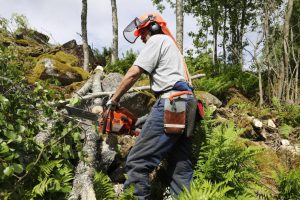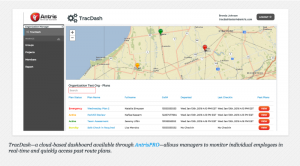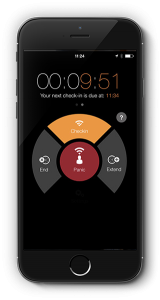Are you reading this at work?
Are you alone?
That’s not a proposition, and it’s not that crazy a question these days.
Some 15 percent of the overall workforce in Canada, the U.S., and Europe are said to be “lone workers”, people who work alone continuously or at various times throughout their workday. There are an estimated 1.3 billion mobile workers around the world, according to International Data Corporation (IDC) estimates.

Anyone working alone needs some kind of support and interaction, the kind that new high-tech systems and smartphone applications can deliver.
Mobile work or working alone are umbrella terms for those types of employment in which work-related tasks and duties take place where the worker cannot be seen or heard by a co-worker.
If there’s injury, ill health or an emergency in the workplace, anyone working alone needs some kind of support and interaction, the kind that new high-tech systems and smartphone applications can deliver.
Obviously, workers are alone and potentially at additional risk if they travel to and from isolated areas, or if they work in confined spaces (like fluid tanks, grain bins or elevators) or at heights (hydro linemen, forestry workers). Even your local convenience store clerk works alone at some point, and the cash nearby is another potential risk factor.

Working alone is an umbrella term for many types of employment in which work-related tasks and duties take place where the worker cannot be seen or heard by a co-worker.
Unlike most provinces in Canada, Ontario does not have specific regulations to address working alone (there is an overall employer duty to maintain a safe workplace); the other provinces and territories do at least have some regulations that require reasonable precautions be taken by employers to protect lone workers.
Training, awareness, and information are crucial components of that protection, but more and more, technological tools are also being used to reduce risks for lone workers.
Communication devices using satellite, cellular or Wi-Fi are great ways to remain in contact with lone or remote location workers. Smartphone apps bring together other device capabilities, too, like GPS, time and date stamps, and automatic or pre-scheduled audible alerts; even the accelerometer can be used to provide valuable information about a worker’s status. And because smartphones are two-way communication tools, the worker can call for help or assistance if needed.

Antris worker protection solutions are available on Apple, Android and Blackberry mobile devices and are integrated across Web, text and call-in platforms.
London, ON-based tech company Antris is one of the leading developers of lone worker protection tools, including integrated smartphone apps and cloud-based SaaS (software as a service) platforms.
Significantly, Antris is one of the first Canadian companies to make use of another Canadian development, a geolocation mapping tool and geographic information system known as ArcGIS that scan map and update employee locations in real-time. The AntrisPRO app allows workers to check in through their mobile devices and it sends automated notifications to supervisors when workers may be at risk.
Of course, shared worker and employer participation in any such protection program is crucial to its success, and to the protection of both worker and employer’s privacy considerations.
Antris instructs its users and system administrators to clearly communicate and jointly select appropriate monitoring features in its lobe worker apps, such as check-in frequency (the worker must respond to simple app prompt every hour or two).
Antris worker protection solutions are available on Apple, Android and Blackberry mobile devices and are integrated across Web, text and call-in platforms.
But the scope of communication and safety solutions like those from Antris can do more than provide protection for workers (the primary function): customized reports can deliver insights and information about organizational and individual workflow, productivity, and resource allotment.

An award-winning Canadian-developed smartphone app designed for organizations with work-alone or at-risk personnel.
Another Canadian-developed smartphone app designed for organizations with work-alone or at-risk personnel (or any staff member who makes personal safety a priority while traveling) called StaySafe has recently been awarded a Reader’s Choice Award in Mobile Apps by Canadian Occupational Safety Magazine.
It’s also linked to a cloud-based hub in which monitoring takes place, tracking lone workers on a map and providing employers with real-time updates on their movements.
Should a lone worker fail to check-in safely, a notification will pop-up on a monitor screen and be delivered via SMS text and email so locating the worker and getting help right away can begin immediately.
Privacy is still an important factor in the worker safety equation. Again, such monitoring tools and cloud-based hubs do keep records about employee activity, so a mutual understanding and buy-in to the program by both employees and management is crucial for its success in protecting and connecting lone workers.
Because work is hard enough these days, whether you’re toiling away in a crowded office, an empty basement or a remote location.
-30-



